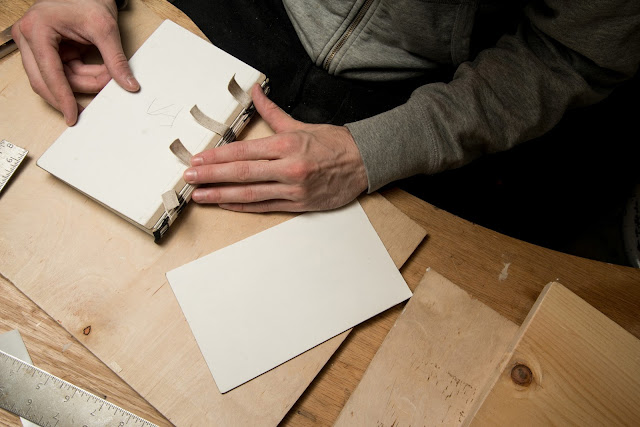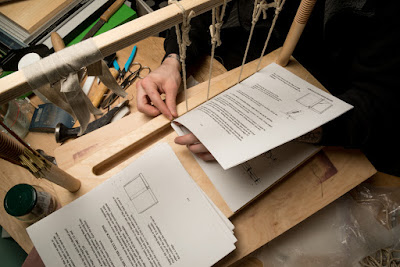The Carpenters Springback
Trouble arose this morning. Attempts to loosen the levers, spring
already attached, were met with ripping, tearing delamination sounds.
The spring had been prepared, dried, attached and dried again before I
had started so moisture wasn't an issue. I slowly worked one side then
the other, switching back and forth. I crammed a bone folder down the
spine trying to see if I could loosen a possible attachment point where
on an earlier book adhesive had oozed between the clowthings during the
attachment of the spine and had firmly adhered the spine of the book to
the spring, also causing issues upon opening. This however was not the
case here, I try to open up a little more same delamination sounds. At
this point I decided; wherever it was that was breaking down was beyond
the point of simple repair. I opened the book by the lever with gentle
but firm pressure, It fought me at first which is normal for a spring
back binding but, at the half way open point, instead of springing up
into the reverse round and presenting the pages the spring had almost
entirely come off. What had happened, what the noise was, was the fabric
that held the spring to the book block and levers had been ripped off
the surface of the inside of the spring and allowed it to come off
entirely.
After briefly panicking I decided to go for a walk and grab a coffee before resuming, to think through what went wrong and how to fix it. Here is some of what I came up with:
Because of the size of the book (10" x 14" x 2.25") I had used a thicker weight upholstery linen as the fabric liner on the spring. Maybe the extra thickness and inflexibility caused an issue.
Davey board spring - the spring was made with .07" board and wrapped in acid free kraft paper. A very strong spring.
Linen cord endbands - Less flexible than maybe I needed. The kicker being later that day I tried for the first time sewing on parchment cores which I found to be significantly more flexible and nicer to work with.
The attachment of fabric to spring by design is insufficient to account for the forces it is subject to.
I have read that once the spine is attached that the book should not be opened until the covering material has been attached.
Upon returning I jumped back into it, first removing the spring cloth that remained attached to the levers. By what is left behind you can see I did a better job on one side than the other.
I had a thinner gauge of 100% linen cloth on hand and went ahead and prepared a piece with homemade spray starch and an iron. Once prepped it is glued to the inside of the spring as usual. I then drilled out two holes 1/4" apart 1/8" from the edge of the spring and 1/4" into the area of the cloth. I then cut out four 4" x 3/32" strips of parchment and fed them through the drilled out holes from the inside to the outside. Each had the loose ends tied in square knots, trimmed, spread with PVA hammered flat and consolidated to a round little rivet shape. Tackets, yes the answer must be tackets! The idea for theses parchment stitches come from the very beginnings of bookbinding and from what I can tell if they are good enough to last 500 years as part of a structure then they are definitely good enough here.
After briefly panicking I decided to go for a walk and grab a coffee before resuming, to think through what went wrong and how to fix it. Here is some of what I came up with:
Because of the size of the book (10" x 14" x 2.25") I had used a thicker weight upholstery linen as the fabric liner on the spring. Maybe the extra thickness and inflexibility caused an issue.
Davey board spring - the spring was made with .07" board and wrapped in acid free kraft paper. A very strong spring.
Linen cord endbands - Less flexible than maybe I needed. The kicker being later that day I tried for the first time sewing on parchment cores which I found to be significantly more flexible and nicer to work with.
The attachment of fabric to spring by design is insufficient to account for the forces it is subject to.
I have read that once the spine is attached that the book should not be opened until the covering material has been attached.
Upon returning I jumped back into it, first removing the spring cloth that remained attached to the levers. By what is left behind you can see I did a better job on one side than the other.
I
decided the endbands and the spring would stay the same moving forward.
Both had been used before in other projects with success and the
advantages possibly to be gained with their replacement I considered
dubious at best. I also have always had issues with the idea that if the
book was opened after the spring was attached but before the covering
material had been then the structure itself could be ruined. Without any
further explanation of why that may be the case I've always assumed
that the structure needed the covering material for strength. But I've
hated that idea, that one couldn't check the action or anything else
within the book until it was all but finished. Not to mention that if
the covering material had to be structural it would affect the aesthetic
choices that could be made by limiting the choices of materials
available. No, even if it was standard or tradition I would need to find
another way around it. The books I will make won't be ruined by opening
them.
So Here's What I Did:I had a thinner gauge of 100% linen cloth on hand and went ahead and prepared a piece with homemade spray starch and an iron. Once prepped it is glued to the inside of the spring as usual. I then drilled out two holes 1/4" apart 1/8" from the edge of the spring and 1/4" into the area of the cloth. I then cut out four 4" x 3/32" strips of parchment and fed them through the drilled out holes from the inside to the outside. Each had the loose ends tied in square knots, trimmed, spread with PVA hammered flat and consolidated to a round little rivet shape. Tackets, yes the answer must be tackets! The idea for theses parchment stitches come from the very beginnings of bookbinding and from what I can tell if they are good enough to last 500 years as part of a structure then they are definitely good enough here.
How did it turn out?
I
am still a couple steps out from the final book but all signs are
pointing to success and once the tacketed spring was reattached to the
book and dried it opened quiet as a mouse and springy too.











Comments
Post a Comment